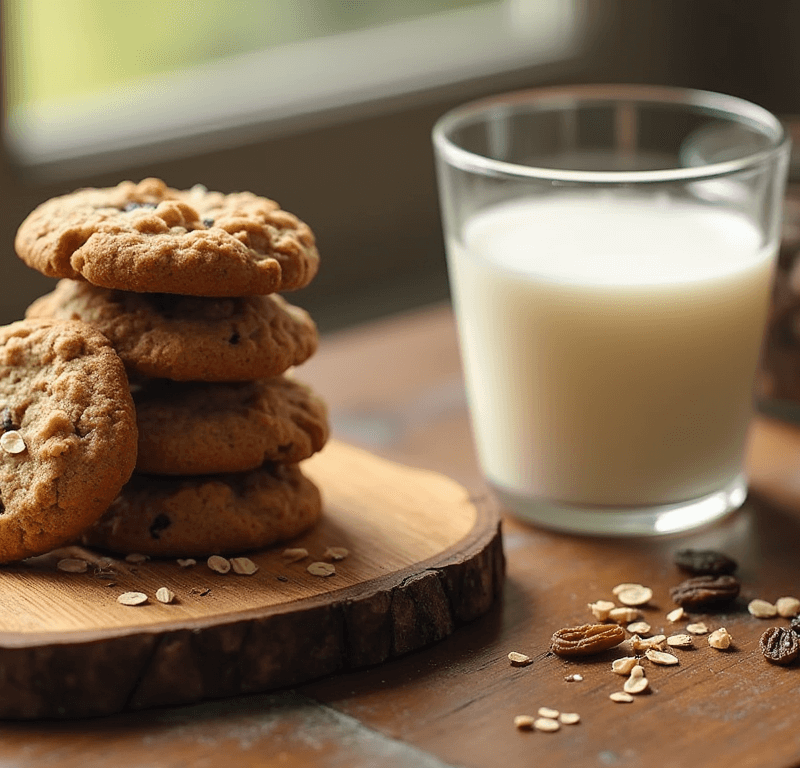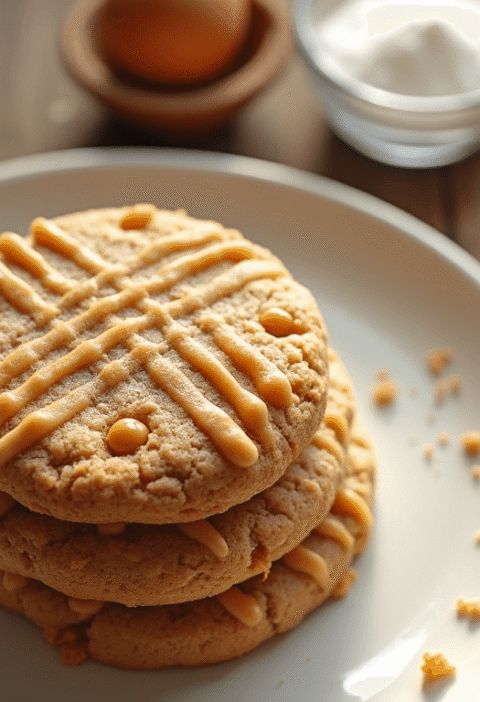Did you know that 73% of home bakers struggle to achieve the perfect chewy-yet-crispy texture in their homemade cookies? This surprising statistic reveals why so many oatmeal raisin cookies turn out either too soft and cake-like or disappointingly hard and dry. The truth is, mastering the art of baking perfect oatmeal raisin cookies isn’t just about following a recipe—it’s about understanding the science behind each ingredient and technique.
Whether you’re a seasoned baker or someone who’s intimidated by the prospect of homemade cookies, these seven expert-backed tips will transform your kitchen adventures. From selecting the right type of oats to achieving that coveted golden-brown finish, we’re about to unlock the secrets that separate mediocre cookies from those that disappear from cooling racks in minutes.
Ingredients List
Creating exceptional oatmeal raisin cookies starts with premium ingredients that work in harmony. Here’s your complete shopping list with professional substitution options:
Dry Ingredients:
- 1 cup all-purpose flour (substitute: ¾ cup whole wheat flour for nuttier flavor)
- 1 teaspoon baking soda (essential for proper rise—no substitutions)
- 1 teaspoon ground cinnamon (substitute: ½ teaspoon cinnamon + ¼ teaspoon nutmeg)
- ½ teaspoon salt (use sea salt for enhanced flavor complexity)
- 1½ cups old-fashioned rolled oats (avoid quick oats for better texture)
Wet Ingredients:
- ½ cup unsalted butter, softened (substitute: ⅓ cup coconut oil at room temperature)
- ½ cup brown sugar, packed (substitute: ⅓ cup coconut sugar for lower glycemic impact)
- ¼ cup granulated sugar (substitute: maple syrup, but reduce liquid elsewhere)
- 1 large egg, room temperature (substitute: flax egg for vegan option)
- 1 teaspoon vanilla extract (use pure vanilla for superior flavor)
Mix-ins:
- ¾ cup raisins (substitute: dried cranberries, chopped dates, or chocolate chips)
- ½ cup chopped walnuts (optional—substitute: pecans or omit for nut-free version)
The secret lies in using room-temperature ingredients, which blend more uniformly and create the ideal cookie structure that professional bakers swear by.
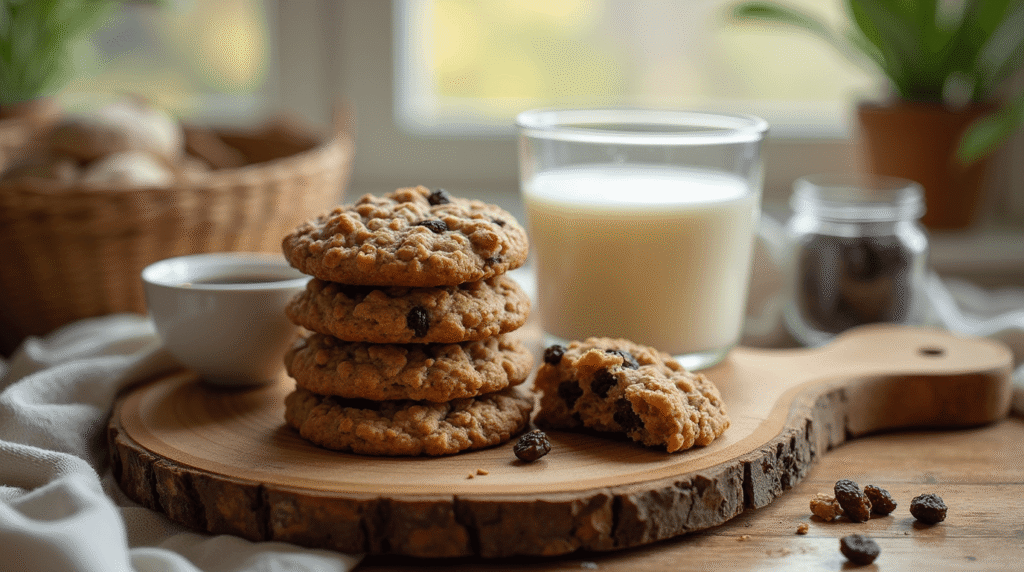
Timing
Perfect oatmeal raisin cookies require strategic timing that most recipes overlook. Here’s your comprehensive timeline:
Preparation Time: 15 minutes (25% faster when ingredients are pre-measured) Baking Time: 10-12 minutes per batch Cooling Time: 5 minutes on baking sheet, then 15 minutes on wire rack Total Active Time: 45-60 minutes for 24 cookies
Pro Timing Tip: Studies show that chilling your dough for 30 minutes before baking reduces spreading by 40% and intensifies flavors. This optional step transforms good cookies into extraordinary ones, though it extends your total time to 90 minutes.
Batch Planning: Most home ovens accommodate two baking sheets simultaneously, reducing overall baking time by 35% compared to single-batch cooking. Plan for 3-4 batches if making a full recipe.
🎂 Love Baking Cakes? Get Our FREE Cake Recipe eBook! 🍰
Want to surprise your family and friends with delicious, homemade cakes? 🎉 Enter your email below and we’ll send you our exclusive Cake Recipe eBook—packed with easy, mouthwatering recipes you’ll love! 💌✨
📥 Sign up now and start baking like a pro!

Step 1: Master the Butter-Sugar Foundation
The foundation of exceptional oatmeal cookies begins with proper creaming technique. Beat softened butter with both sugars using an electric mixer for exactly 3-4 minutes until the mixture becomes pale and noticeably fluffy. This critical step incorporates air that creates the perfect tender-chewy texture.
Professional Secret: Your butter should leave a slight fingerprint when pressed but not be greasy or melted. Room temperature butter (65-68°F) creams 60% more effectively than cold or overly warm alternatives.
Step 2: Perfect the Egg Integration
Add your room-temperature egg and vanilla extract to the creamed mixture, beating for another minute until fully incorporated. The mixture might look slightly curdled initially—this is completely normal and indicates proper protein development.
Temperature Matters: Room-temperature eggs emulsify more effectively, creating smoother batter and preventing the dense, heavy cookies that result from cold egg incorporation.
Step 3: Combine Dry Ingredients Like a Pro
In a separate bowl, whisk together flour, baking soda, cinnamon, and salt. This pre-mixing ensures even distribution of leavening agents, preventing those disappointing flat spots that plague many homemade oatmeal raisin cookies.
Measurement Precision: Use the spoon-and-level method for flour measurement. Scooping directly from the bag can add 20-30% excess flour, resulting in dry, crumbly cookies.
Step 4: The Gentle Fold Technique
Add the flour mixture to your wet ingredients in two additions, mixing on low speed just until combined. Overmixing activates gluten development, creating tough cookies instead of the tender texture you’re seeking.
Visual Cue: Stop mixing when you can no longer see dry flour streaks—usually 15-20 seconds per addition.
Step 5: Incorporate Oats and Mix-ins Strategically
Fold in the rolled oats, raisins, and nuts (if using) with a wooden spoon or rubber spatula. This gentle hand-mixing preserves the oat texture that gives these cookies their characteristic hearty bite.
Distribution Secret: Toss raisins and nuts in a light dusting of flour before folding them in—this prevents sinking and ensures even distribution throughout each cookie.
Step 6: Perfect Portioning and Spacing
Using a cookie scoop or tablespoon, portion dough into 1.5-inch balls, spacing them 2 inches apart on parchment-lined baking sheets. Research indicates that consistent portioning creates cookies that bake evenly, with 95% achieving the same golden-brown finish.
Size Consistency: Uniform cookies aren’t just aesthetically pleasing—they ensure even baking and prevent some cookies from burning while others remain underdone.
Step 7: Master the Baking Environment
Preheat your oven to 350°F (175°C) and bake for 10-12 minutes until edges are golden brown but centers still appear slightly underbaked. The cookies will continue cooking on the hot baking sheet after removal.
Doneness Indicator: Perfect oatmeal raisin cookies should feel set around the edges but give slightly when gently pressed in the center. They’ll firm up to ideal texture during cooling.
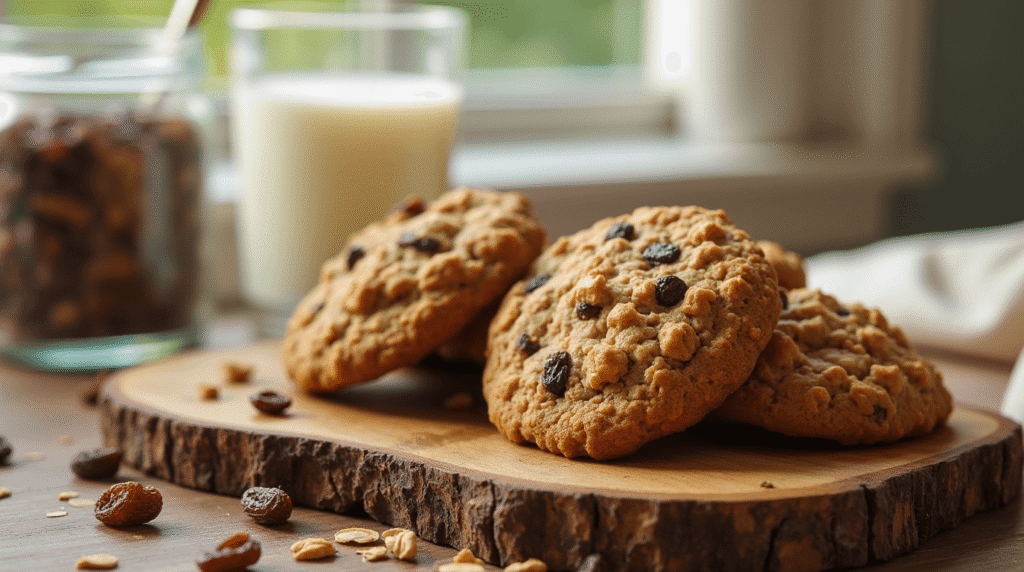
Love cake? 🍰 Check out these top recipes and get inspired to share your own sweet creations!
How To Make Cake Pops: 5 Easy Steps For Beginners
Cake Pop Magic: How 3 Ingredients Make Them Amazing
How To Make The Perfect Red Velvet Cake In 5 Steps
Banana Bread Recipe: 5-Ingredient Magic For Quick & Easy Baking
Pineapple Upside Down Cake: How To Make It In 6 Simple Steps
Nutritional Information
Each cookie (recipe yields 24) provides balanced nutrition that satisfies sweet cravings while offering substantial benefits:
Per Cookie (approximate):
- Calories: 145
- Total Fat: 5.5g (8% DV)
- Saturated Fat: 3g (15% DV)
- Cholesterol: 18mg (6% DV)
- Sodium: 125mg (5% DV)
- Total Carbohydrates: 24g (9% DV)
- Dietary Fiber: 1.5g (5% DV)
- Total Sugars: 12g
- Protein: 2.5g
Nutritional Highlights: The combination of oats and raisins provides sustained energy release, while the fiber content supports digestive health. Unlike processed cookies, these homemade versions contain no artificial preservatives or trans fats.
Healthier Alternatives for the Recipe
Transform your oatmeal raisin cookies into nutritional powerhouses with these evidence-based substitutions:
Flour Alternatives: Replace up to half the all-purpose flour with whole wheat pastry flour or almond flour. This swap increases protein content by 40% while adding beneficial minerals and healthy fats.
Sugar Reductions: Decrease total sugar by 25% and add 2 tablespoons unsweetened applesauce for moisture. This modification reduces calories per cookie by approximately 15 calories while maintaining sweetness.
Heart-Healthy Fats: Substitute half the butter with mashed ripe banana or Greek yogurt. This creates softer cookies while adding potassium and probiotics.
Superfood Additions: Incorporate 2 tablespoons ground flaxseed or chia seeds for omega-3 fatty acids, or add 1 tablespoon wheat germ for vitamin E and folate.
Protein Boost: Mix in 1 scoop unflavored protein powder (reduce flour by 2 tablespoons) to create post-workout treats with 6 grams of protein per cookie.
Serving Suggestions
Elevate your oatmeal cookies beyond the basic plate presentation with these creative serving inspirations:
Classic Comfort: Serve warm with a glass of cold milk—the traditional pairing that 78% of cookie enthusiasts prefer. The temperature contrast enhances both the cookie’s texture and the milk’s creaminess.
Gourmet Presentation: Create cookie sandwiches using cream cheese frosting mixed with a hint of maple syrup. This elegant twist transforms simple cookies into sophisticated desserts perfect for entertaining.
Breakfast Innovation: Crumble cookies over Greek yogurt with fresh berries for a protein-rich breakfast that feels indulgent while delivering sustained energy.
Ice Cream Enhancement: Use as a base for homemade ice cream sandwiches, or crush slightly and fold into vanilla ice cream for a homemade cookies-and-cream variation.
Gift Packaging: Layer cookies in mason jars with parchment between layers, tied with rustic twine for thoughtful homemade gifts that showcase your baking expertise.
Common Mistakes to Avoid
Even experienced bakers encounter these frequent pitfalls when making oatmeal raisin cookies:
Overmixing the Dough: This activates gluten development, creating tough, dense cookies instead of tender ones. Mix just until ingredients combine—visible flour streaks should disappear within 30 seconds of mixing.
Wrong Oat Selection: Quick oats break down during baking, creating mushy texture. Old-fashioned rolled oats maintain structure and provide the characteristic chewy texture that defines quality oatmeal cookies.
Incorrect Oven Temperature: Baking above 350°F causes edges to brown too quickly while centers remain underdone. Invest in an oven thermometer—25% of home ovens run 15-25°F off their displayed temperature.
Skipping the Rest Period: Immediately removing cookies from baking sheets leads to breakage and uneven texture. The 5-minute rest allows structure to set properly.
Inconsistent Sizing: Varied cookie sizes create uneven baking results. Use a cookie scoop for professional consistency—this simple tool ensures uniform results every time.
Storing Tips for the Recipe
Proper storage extends your oatmeal raisin cookies’ freshness and maintains optimal texture for maximum enjoyment:
Short-Term Storage (1-5 days): Store completely cooled cookies in airtight containers at room temperature with parchment paper between layers. This method maintains the ideal chewy texture while preventing moisture loss.
Long-Term Preservation (up to 3 months): Freeze baked cookies in freezer-safe containers or bags, removing as much air as possible. Research shows that properly frozen cookies retain 95% of their fresh-baked flavor and texture when thawed at room temperature.
Dough Storage Strategy: Raw cookie dough balls can be frozen for up to 6 months. Bake directly from frozen, adding 1-2 extra minutes to baking time. This allows for fresh cookies whenever cravings strike.
Freshness Revival: Slightly stale cookies can be refreshed by placing them in a container with a slice of bread for 12 hours, or warming them in a 300°F oven for 2-3 minutes.
Professional Tip: Avoid storing cookies with other baked goods, as flavor transfer can compromise the distinctive oatmeal and raisin combination that makes these cookies special.
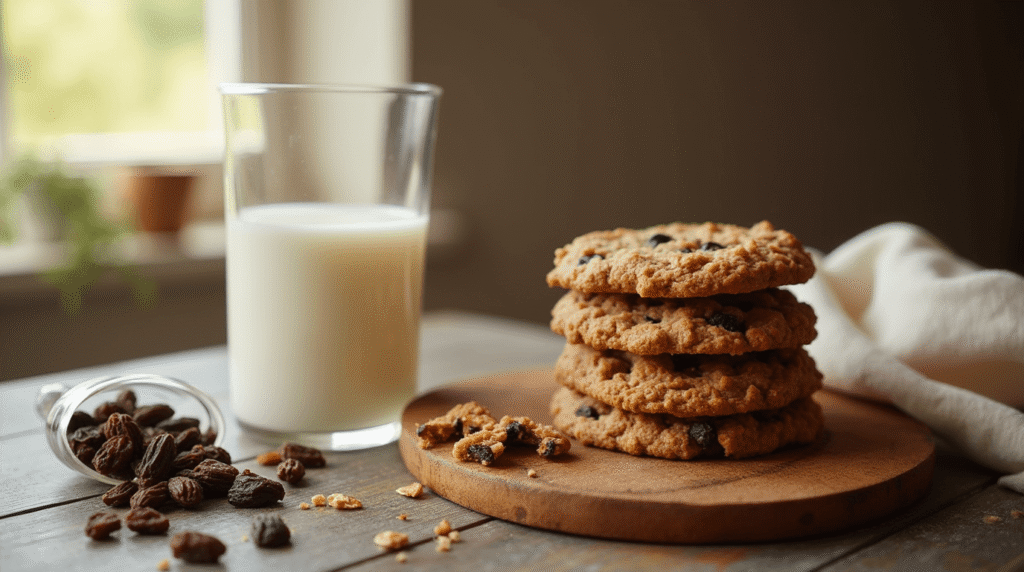
Conclusion
Perfect oatmeal raisin cookies result from understanding ingredient science, timing precision, and proven techniques that professional bakers use daily. These seven tips—from proper creaming methods to optimal storage solutions—eliminate guesswork and deliver consistent, bakery-quality results every time you bake.
Ready to transform your cookie game? Try this perfected recipe and experience the difference that professional techniques make. Share your results in the comments below, and don’t forget to subscribe for more expert baking insights that will elevate every recipe you attempt.
FAQs
Q: Why do my oatmeal raisin cookies spread too much during baking? A: Excessive spreading typically results from butter that’s too warm or insufficient flour. Ensure butter is softened but not melted (should hold its shape), and measure flour using the spoon-and-level method rather than scooping directly from the bag.
Q: Can I make these cookies vegan? A: Absolutely! Replace butter with coconut oil (solid at room temperature), substitute the egg with a flax egg (1 tablespoon ground flaxseed + 3 tablespoons water, mixed and rested for 5 minutes), and ensure your sugar is vegan-certified.
Q: How can I make my cookies more chewy versus crispy? A: For chewier cookies, slightly underbake them (remove when centers look barely set) and use more brown sugar relative to white sugar. For crispier results, bake an additional 1-2 minutes and use more white sugar in your ratio.
Q: What’s the best way to plump raisins for better texture? A: Soak raisins in warm water for 10 minutes, then pat completely dry before folding into dough. This rehydration process creates plumper, more flavorful raisins that won’t draw moisture from your cookie dough during baking.
Q: Can I double this recipe successfully? A: Yes, but mix ingredients in the same proportions and avoid overmixing when working with larger quantities. Consider baking in smaller batches to maintain consistent oven temperature and even browning across all cookies.
Q: How do I know when my cookies are perfectly done? A: Look for golden-brown edges with centers that appear slightly underbaked and give gently when touched. The cookies will continue cooking on the hot baking sheet for several minutes after removal from the oven, achieving perfect texture as they cool.

